ERP Selection: A Comprehensive Guide for Organizations
VerifiedAdded on 2024/05/31
|18
|1297
|314
AI Summary
This presentation delves into the intricate process of selecting an ERP system for organizations. It covers key aspects such as understanding business requirements, identifying potential ERP vendors, evaluating systems, and conducting a fit/gap analysis. The presentation also explores ERP architecture, modules, and implementation considerations. It aims to provide a comprehensive guide for organizations seeking to optimize their operations through ERP adoption.
Contribute Materials
Your contribution can guide someone’s learning journey. Share your
documents today.
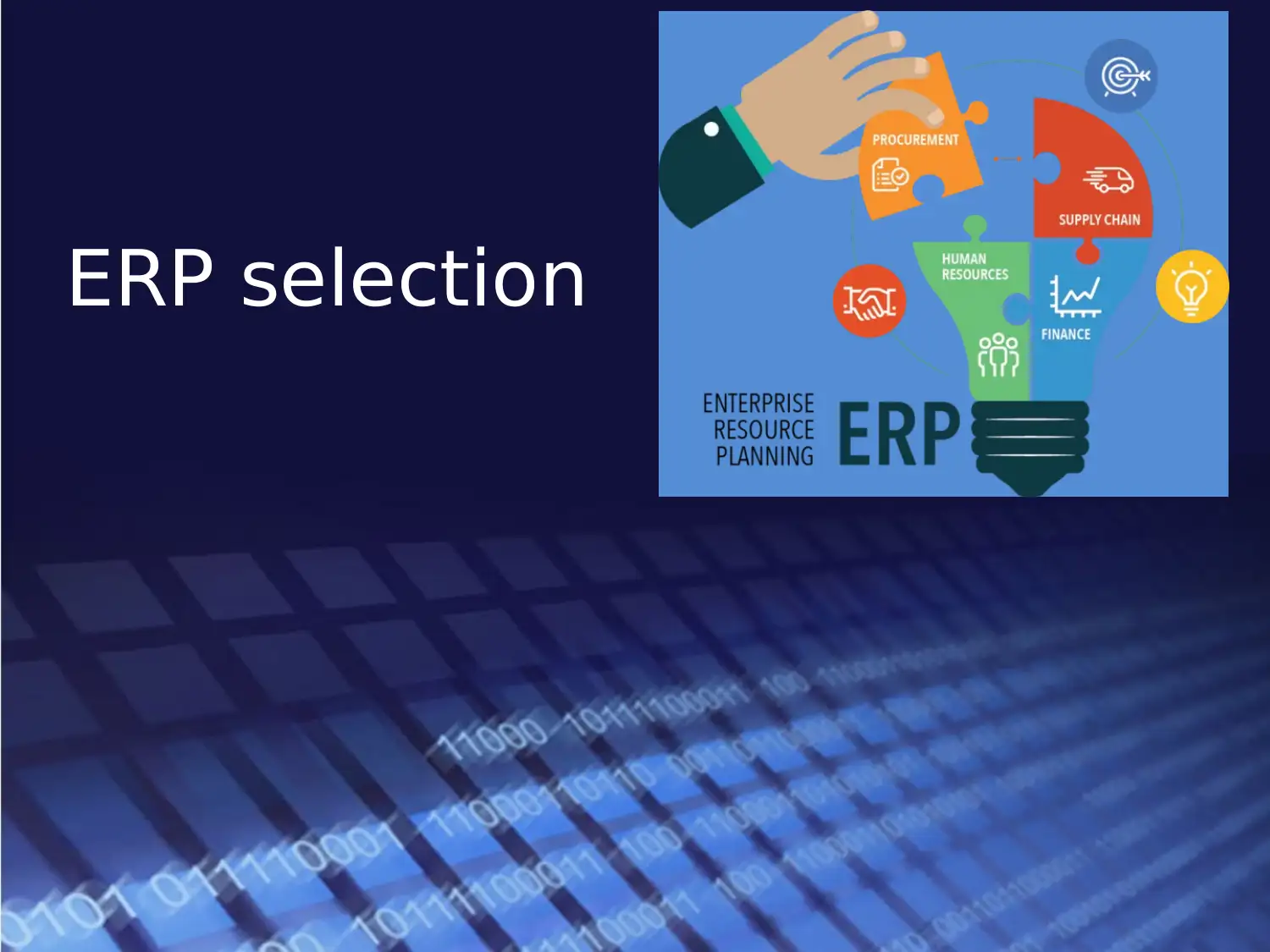
ERP selection
Secure Best Marks with AI Grader
Need help grading? Try our AI Grader for instant feedback on your assignments.
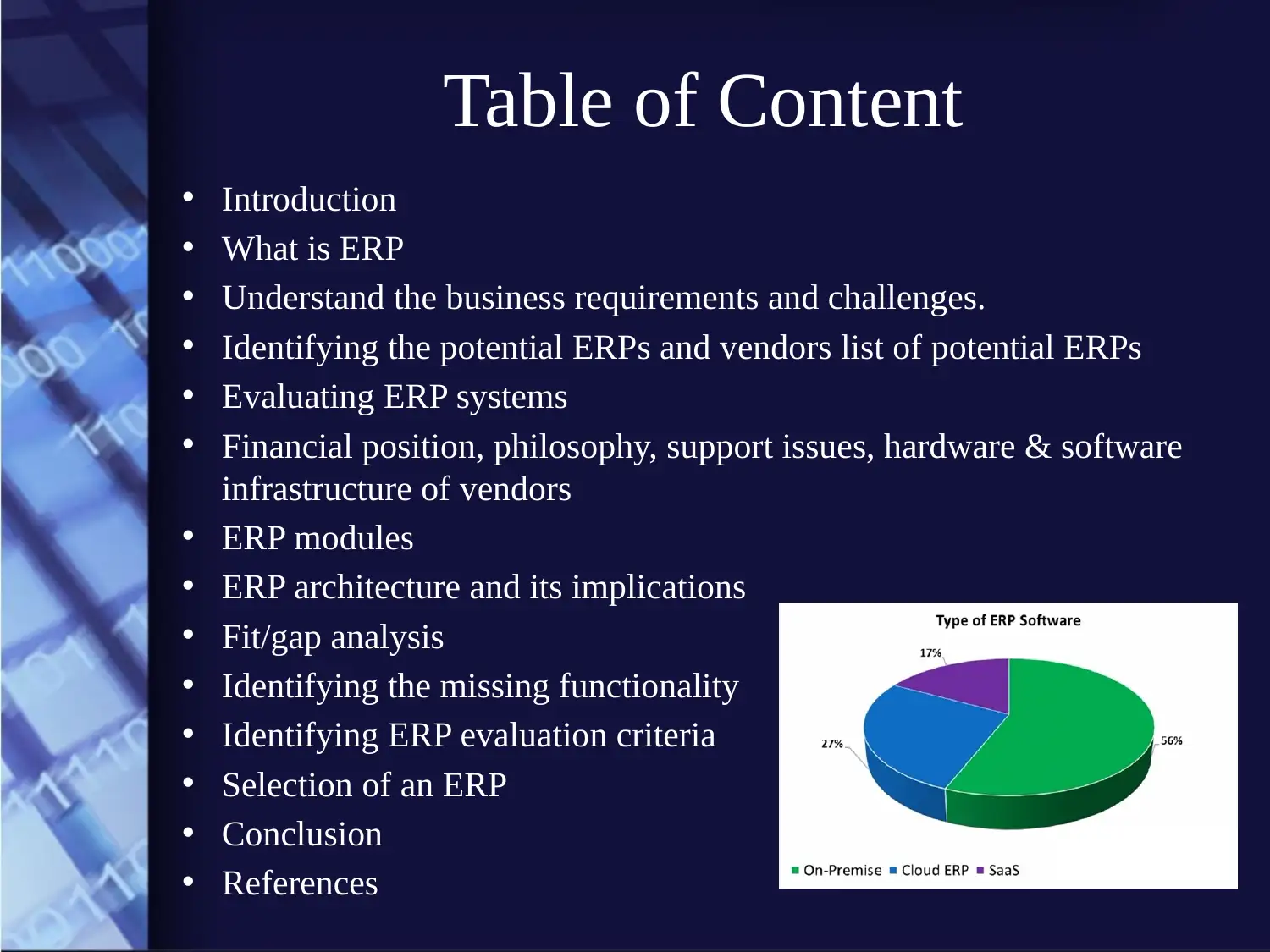
Table of Content
• Introduction
• What is ERP
• Understand the business requirements and challenges.
• Identifying the potential ERPs and vendors list of potential ERPs
• Evaluating ERP systems
• Financial position, philosophy, support issues, hardware & software
infrastructure of vendors
• ERP modules
• ERP architecture and its implications
• Fit/gap analysis
• Identifying the missing functionality
• Identifying ERP evaluation criteria
• Selection of an ERP
• Conclusion
• References
• Introduction
• What is ERP
• Understand the business requirements and challenges.
• Identifying the potential ERPs and vendors list of potential ERPs
• Evaluating ERP systems
• Financial position, philosophy, support issues, hardware & software
infrastructure of vendors
• ERP modules
• ERP architecture and its implications
• Fit/gap analysis
• Identifying the missing functionality
• Identifying ERP evaluation criteria
• Selection of an ERP
• Conclusion
• References

Introduction
• The PPT will be prepared for discussing
the selection of ERP and vendors for the
organisation
• Evaluations of ERP systems will be
completed
• Potentials ERP’s such as SAGE and Odoo
will be discussed
• Discussion on ERP architecture and its
implications will be laid
• The PPT will be prepared for discussing
the selection of ERP and vendors for the
organisation
• Evaluations of ERP systems will be
completed
• Potentials ERP’s such as SAGE and Odoo
will be discussed
• Discussion on ERP architecture and its
implications will be laid
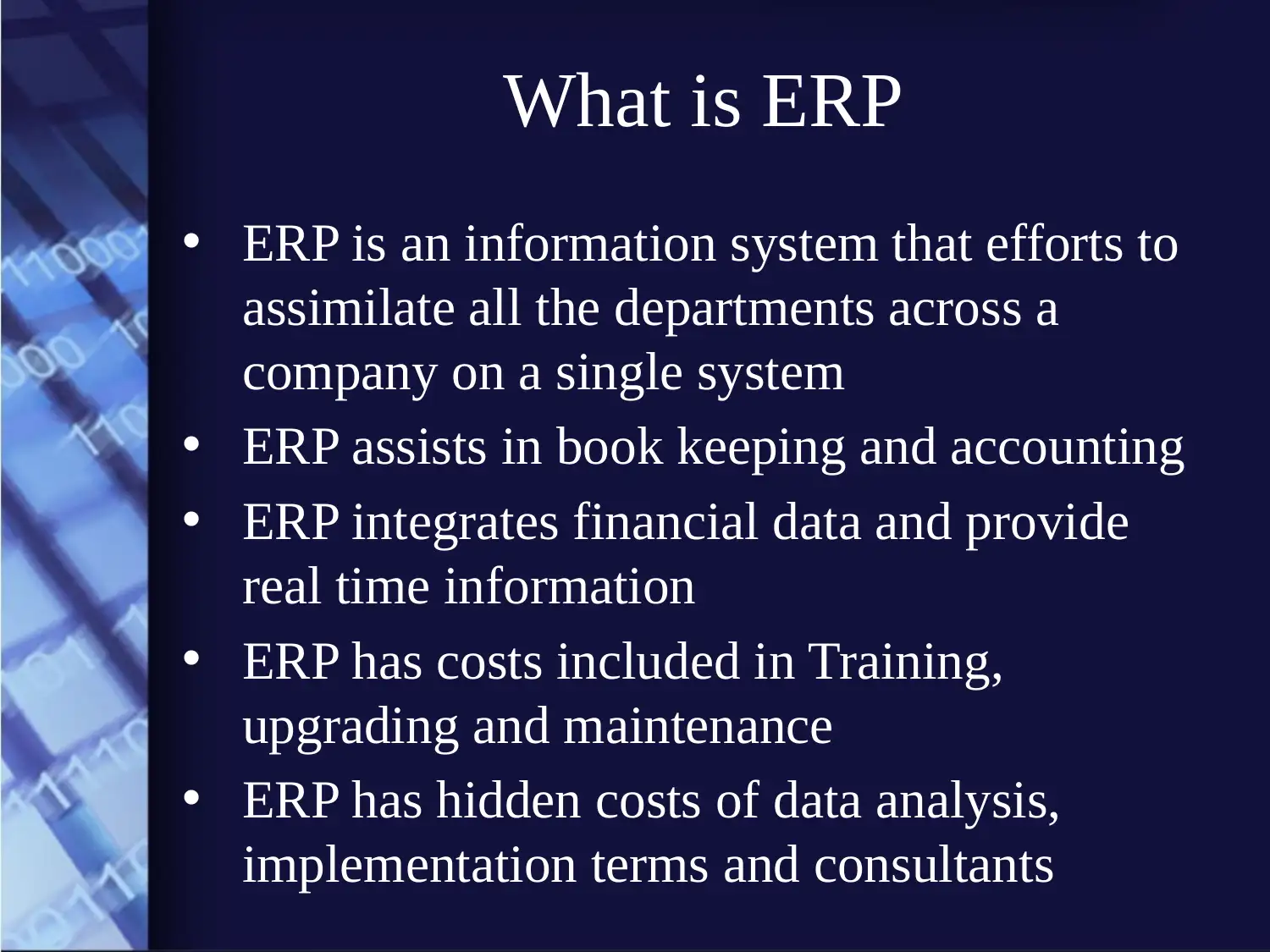
What is ERP
• ERP is an information system that efforts to
assimilate all the departments across a
company on a single system
• ERP assists in book keeping and accounting
• ERP integrates financial data and provide
real time information
• ERP has costs included in Training,
upgrading and maintenance
• ERP has hidden costs of data analysis,
implementation terms and consultants
• ERP is an information system that efforts to
assimilate all the departments across a
company on a single system
• ERP assists in book keeping and accounting
• ERP integrates financial data and provide
real time information
• ERP has costs included in Training,
upgrading and maintenance
• ERP has hidden costs of data analysis,
implementation terms and consultants
Secure Best Marks with AI Grader
Need help grading? Try our AI Grader for instant feedback on your assignments.
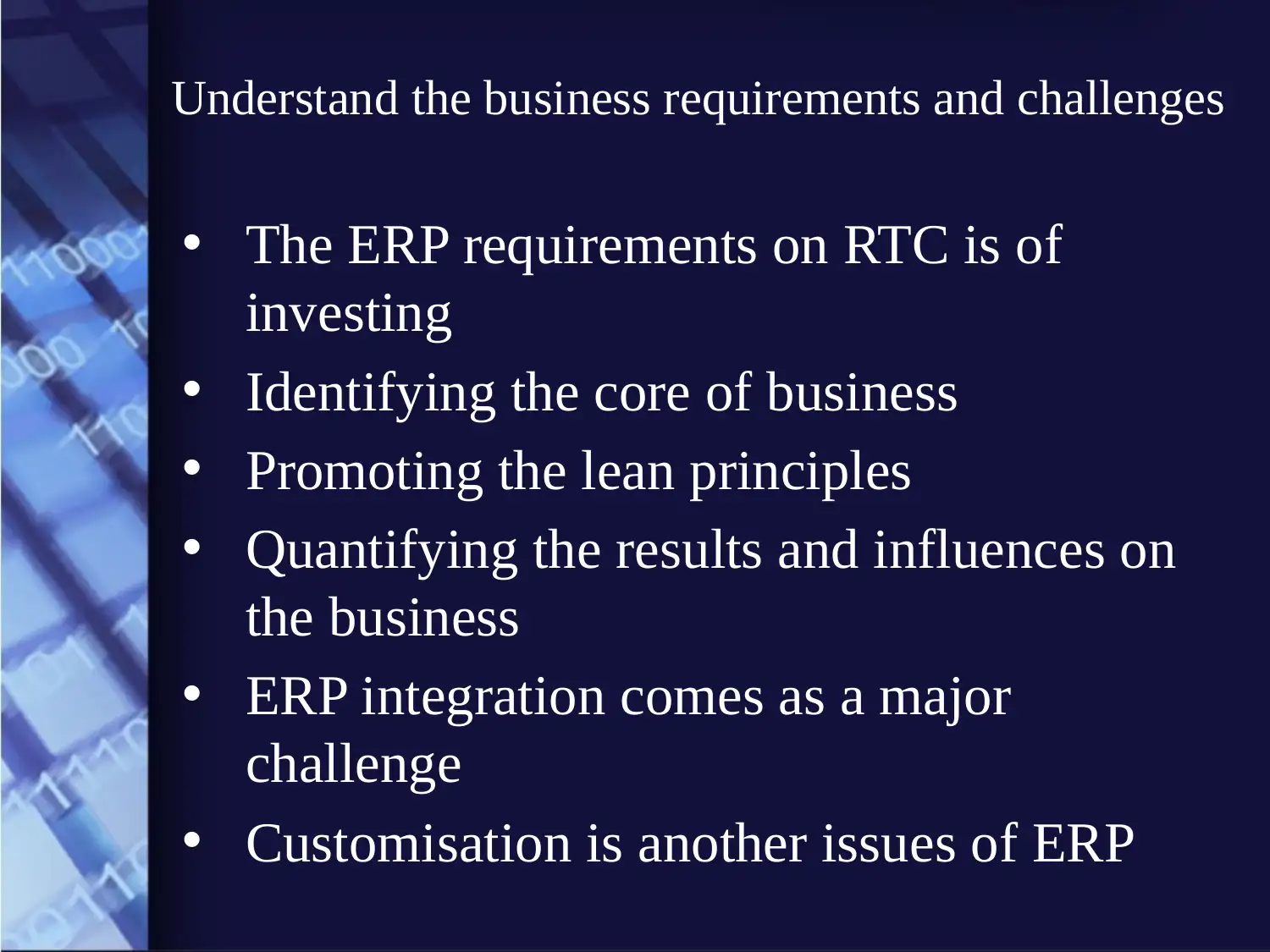
Understand the business requirements and challenges
• The ERP requirements on RTC is of
investing
• Identifying the core of business
• Promoting the lean principles
• Quantifying the results and influences on
the business
• ERP integration comes as a major
challenge
• Customisation is another issues of ERP
• The ERP requirements on RTC is of
investing
• Identifying the core of business
• Promoting the lean principles
• Quantifying the results and influences on
the business
• ERP integration comes as a major
challenge
• Customisation is another issues of ERP
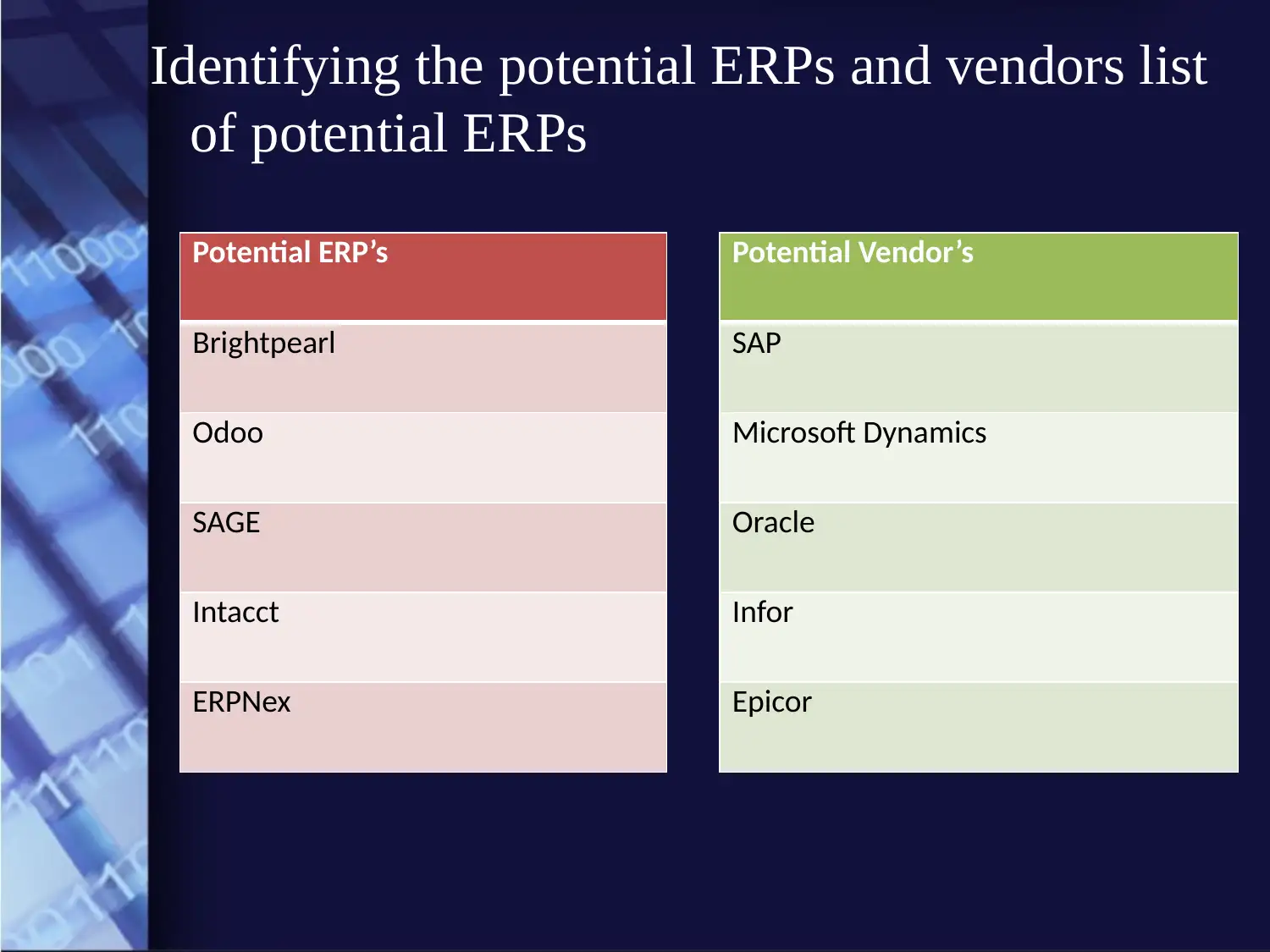
Identifying the potential ERPs and vendors list
of potential ERPs
Potential ERP’s
Brightpearl
Odoo
SAGE
Intacct
ERPNex
Potential Vendor’s
SAP
Microsoft Dynamics
Oracle
Infor
Epicor
of potential ERPs
Potential ERP’s
Brightpearl
Odoo
SAGE
Intacct
ERPNex
Potential Vendor’s
SAP
Microsoft Dynamics
Oracle
Infor
Epicor
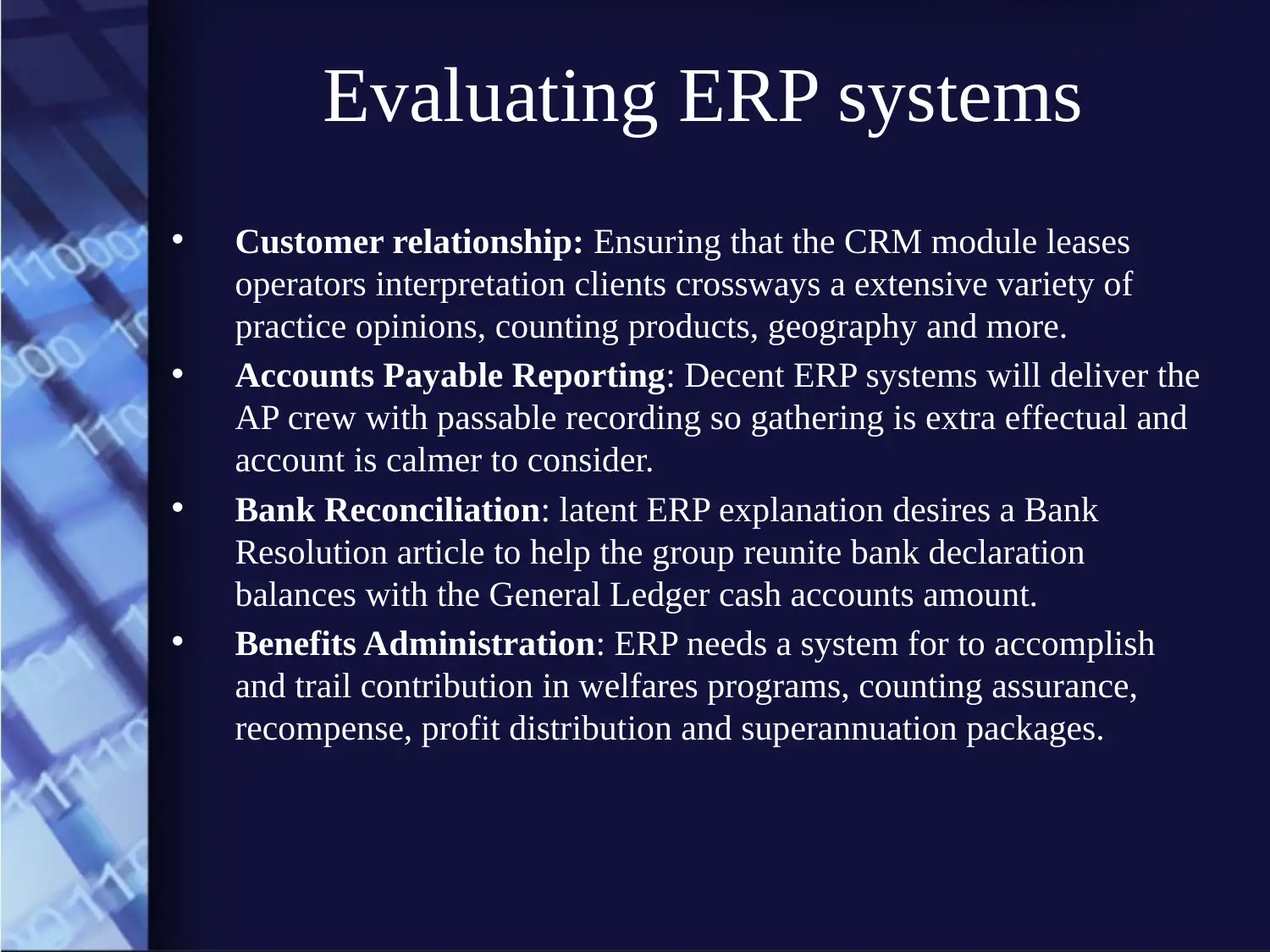
Evaluating ERP systems
• Customer relationship: Ensuring that the CRM module leases
operators interpretation clients crossways a extensive variety of
practice opinions, counting products, geography and more.
• Accounts Payable Reporting: Decent ERP systems will deliver the
AP crew with passable recording so gathering is extra effectual and
account is calmer to consider.
• Bank Reconciliation: latent ERP explanation desires a Bank
Resolution article to help the group reunite bank declaration
balances with the General Ledger cash accounts amount.
• Benefits Administration: ERP needs a system for to accomplish
and trail contribution in welfares programs, counting assurance,
recompense, profit distribution and superannuation packages.
• Customer relationship: Ensuring that the CRM module leases
operators interpretation clients crossways a extensive variety of
practice opinions, counting products, geography and more.
• Accounts Payable Reporting: Decent ERP systems will deliver the
AP crew with passable recording so gathering is extra effectual and
account is calmer to consider.
• Bank Reconciliation: latent ERP explanation desires a Bank
Resolution article to help the group reunite bank declaration
balances with the General Ledger cash accounts amount.
• Benefits Administration: ERP needs a system for to accomplish
and trail contribution in welfares programs, counting assurance,
recompense, profit distribution and superannuation packages.
Paraphrase This Document
Need a fresh take? Get an instant paraphrase of this document with our AI Paraphraser
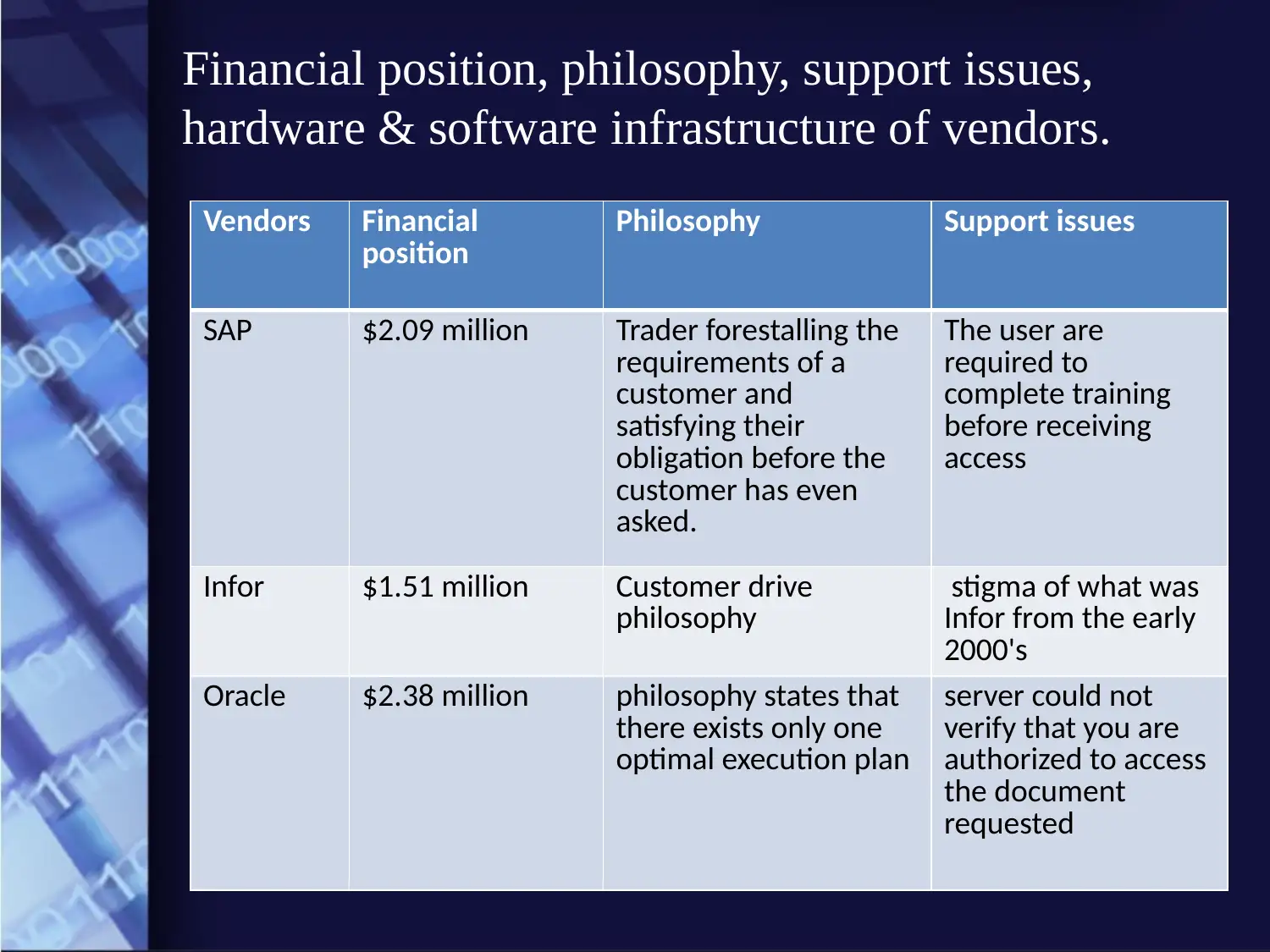
Financial position, philosophy, support issues,
hardware & software infrastructure of vendors.
Vendors Financial
position
Philosophy Support issues
SAP $2.09 million Trader forestalling the
requirements of a
customer and
satisfying their
obligation before the
customer has even
asked.
The user are
required to
complete training
before receiving
access
Infor $1.51 million Customer drive
philosophy
stigma of what was
Infor from the early
2000's
Oracle $2.38 million philosophy states that
there exists only one
optimal execution plan
server could not
verify that you are
authorized to access
the document
requested
hardware & software infrastructure of vendors.
Vendors Financial
position
Philosophy Support issues
SAP $2.09 million Trader forestalling the
requirements of a
customer and
satisfying their
obligation before the
customer has even
asked.
The user are
required to
complete training
before receiving
access
Infor $1.51 million Customer drive
philosophy
stigma of what was
Infor from the early
2000's
Oracle $2.38 million philosophy states that
there exists only one
optimal execution plan
server could not
verify that you are
authorized to access
the document
requested
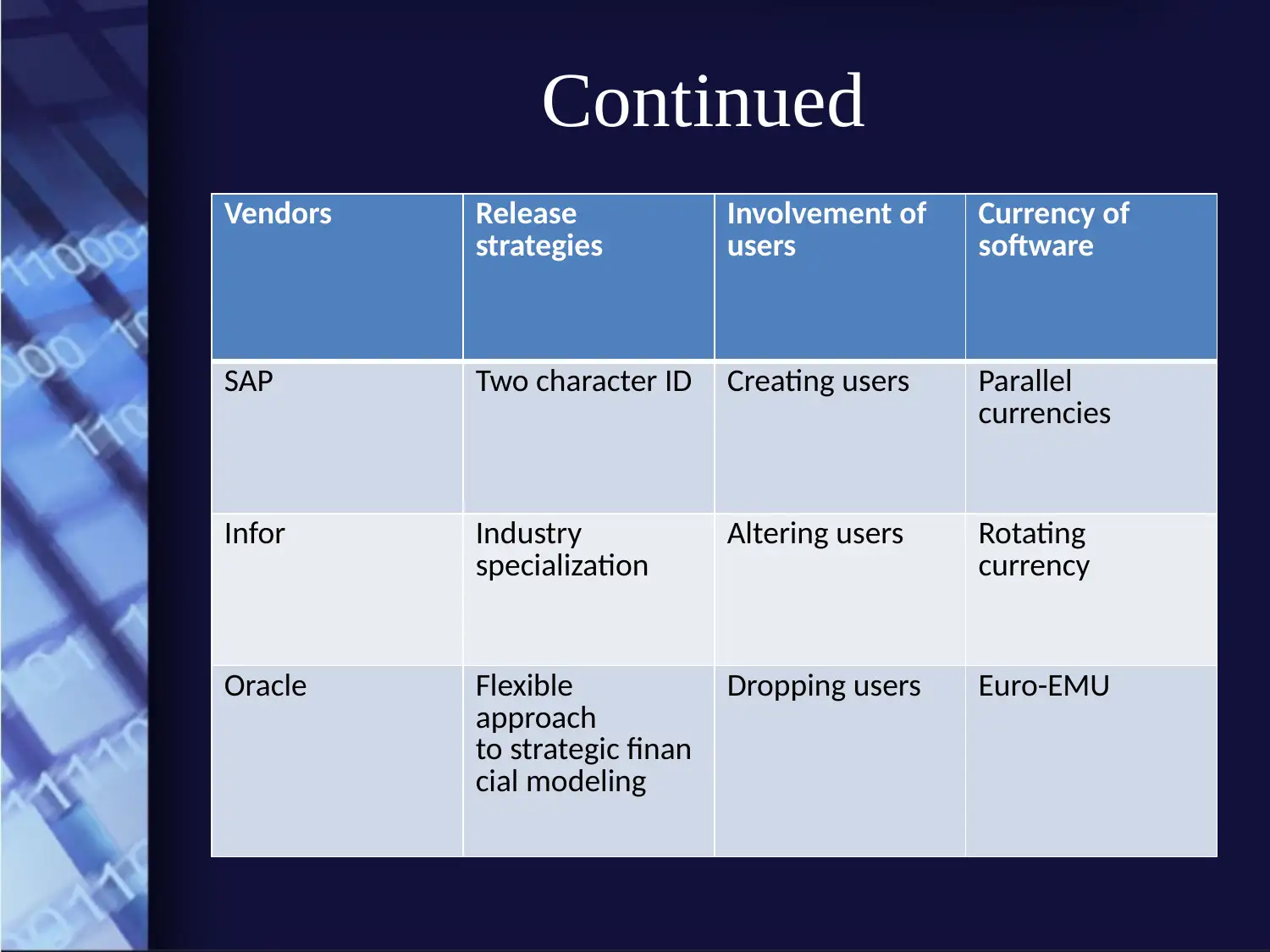
Continued
Vendors Release
strategies
Involvement of
users
Currency of
software
SAP Two character ID Creating users Parallel
currencies
Infor Industry
specialization
Altering users Rotating
currency
Oracle Flexible
approach
to strategic finan
cial modeling
Dropping users Euro-EMU
Vendors Release
strategies
Involvement of
users
Currency of
software
SAP Two character ID Creating users Parallel
currencies
Infor Industry
specialization
Altering users Rotating
currency
Oracle Flexible
approach
to strategic finan
cial modeling
Dropping users Euro-EMU
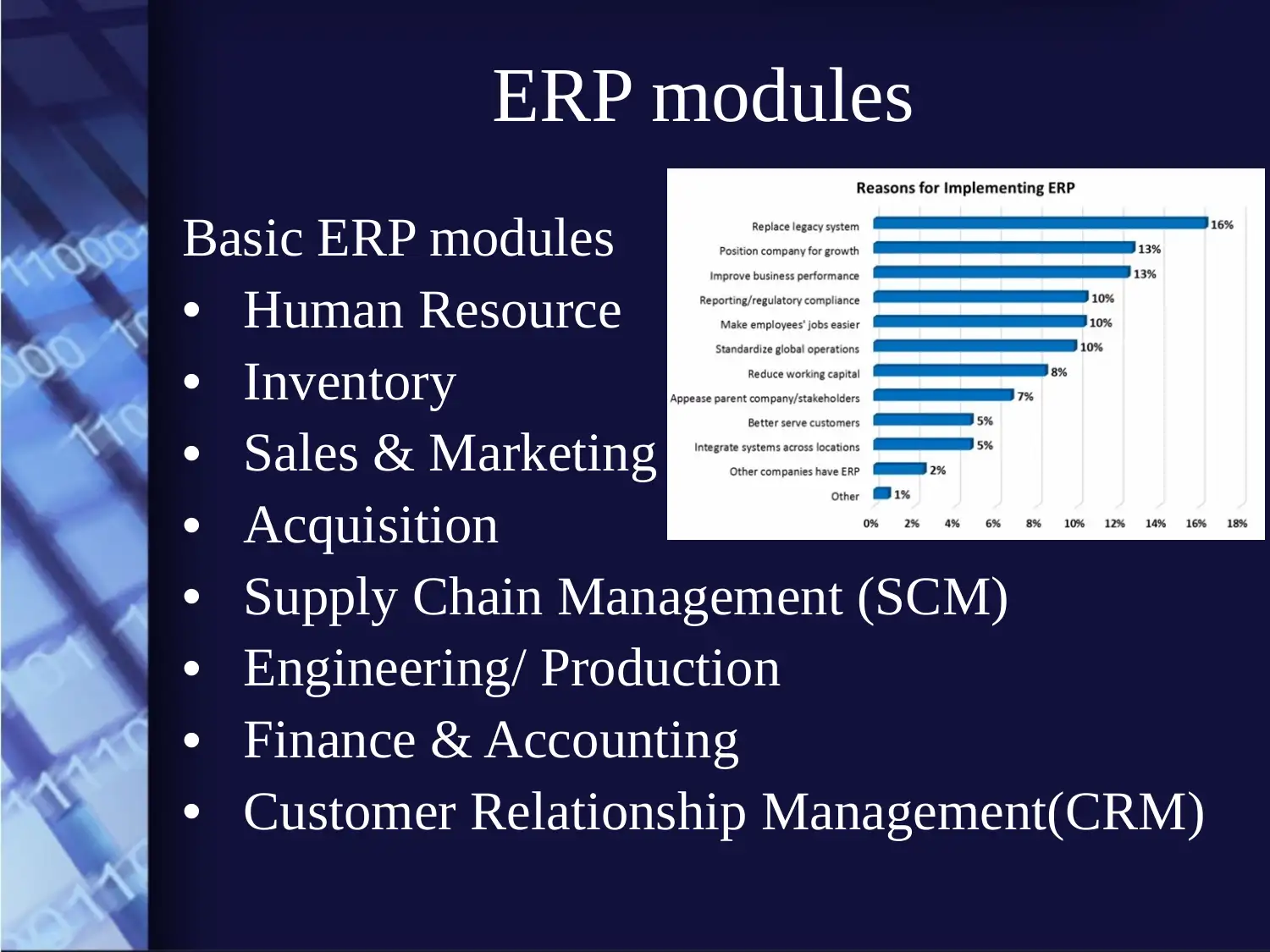
ERP modules
Basic ERP modules
• Human Resource
• Inventory
• Sales & Marketing
• Acquisition
• Supply Chain Management (SCM)
• Engineering/ Production
• Finance & Accounting
• Customer Relationship Management(CRM)
Basic ERP modules
• Human Resource
• Inventory
• Sales & Marketing
• Acquisition
• Supply Chain Management (SCM)
• Engineering/ Production
• Finance & Accounting
• Customer Relationship Management(CRM)
Secure Best Marks with AI Grader
Need help grading? Try our AI Grader for instant feedback on your assignments.
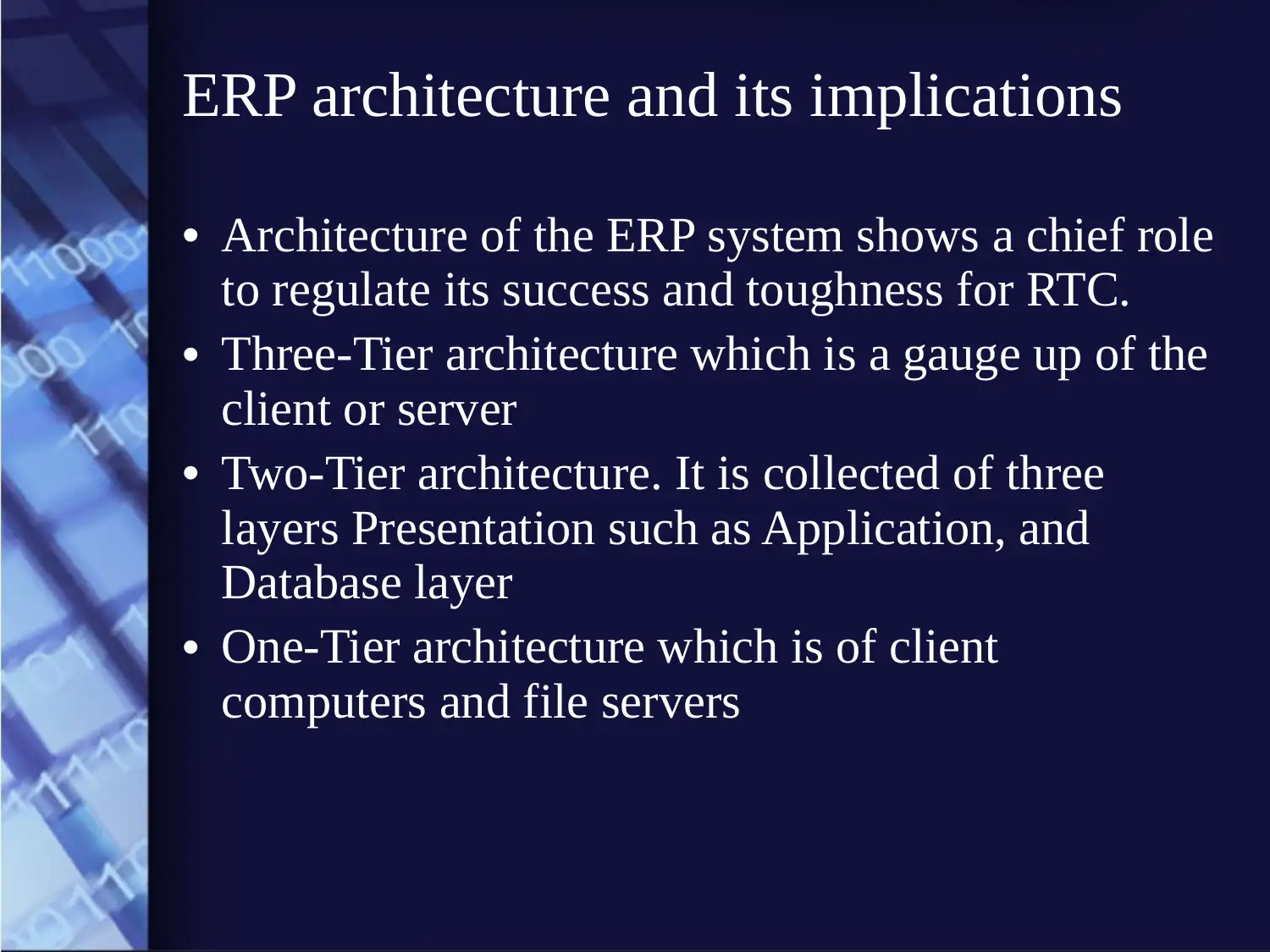
ERP architecture and its implications
• Architecture of the ERP system shows a chief role
to regulate its success and toughness for RTC.
• Three-Tier architecture which is a gauge up of the
client or server
• Two-Tier architecture. It is collected of three
layers Presentation such as Application, and
Database layer
• One-Tier architecture which is of client
computers and file servers
• Architecture of the ERP system shows a chief role
to regulate its success and toughness for RTC.
• Three-Tier architecture which is a gauge up of the
client or server
• Two-Tier architecture. It is collected of three
layers Presentation such as Application, and
Database layer
• One-Tier architecture which is of client
computers and file servers
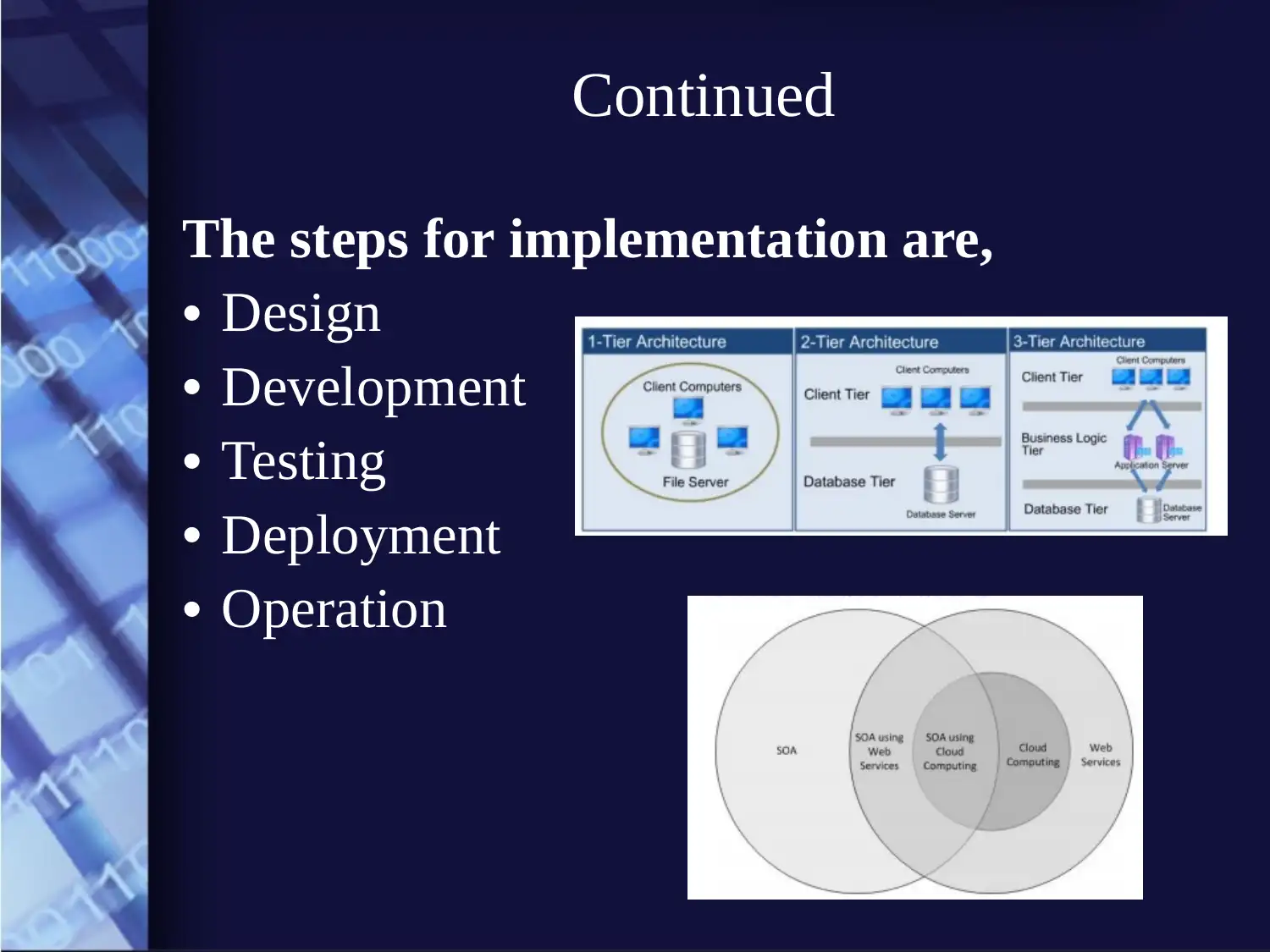
Continued
The steps for implementation are,
• Design
• Development
• Testing
• Deployment
• Operation
The steps for implementation are,
• Design
• Development
• Testing
• Deployment
• Operation
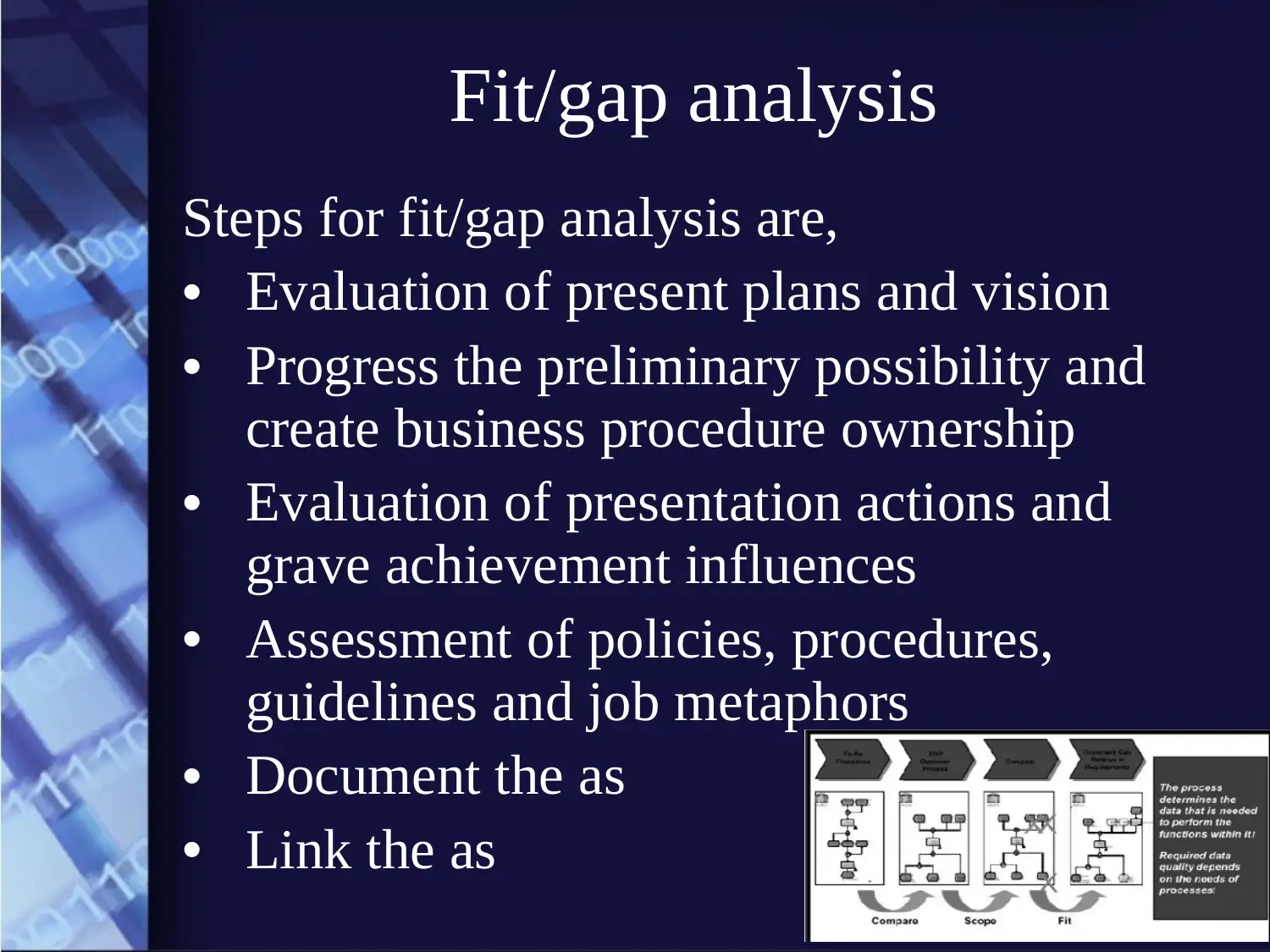
Fit/gap analysis
Steps for fit/gap analysis are,
• Evaluation of present plans and vision
• Progress the preliminary possibility and
create business procedure ownership
• Evaluation of presentation actions and
grave achievement influences
• Assessment of policies, procedures,
guidelines and job metaphors
• Document the as
• Link the as
Steps for fit/gap analysis are,
• Evaluation of present plans and vision
• Progress the preliminary possibility and
create business procedure ownership
• Evaluation of presentation actions and
grave achievement influences
• Assessment of policies, procedures,
guidelines and job metaphors
• Document the as
• Link the as
Paraphrase This Document
Need a fresh take? Get an instant paraphrase of this document with our AI Paraphraser
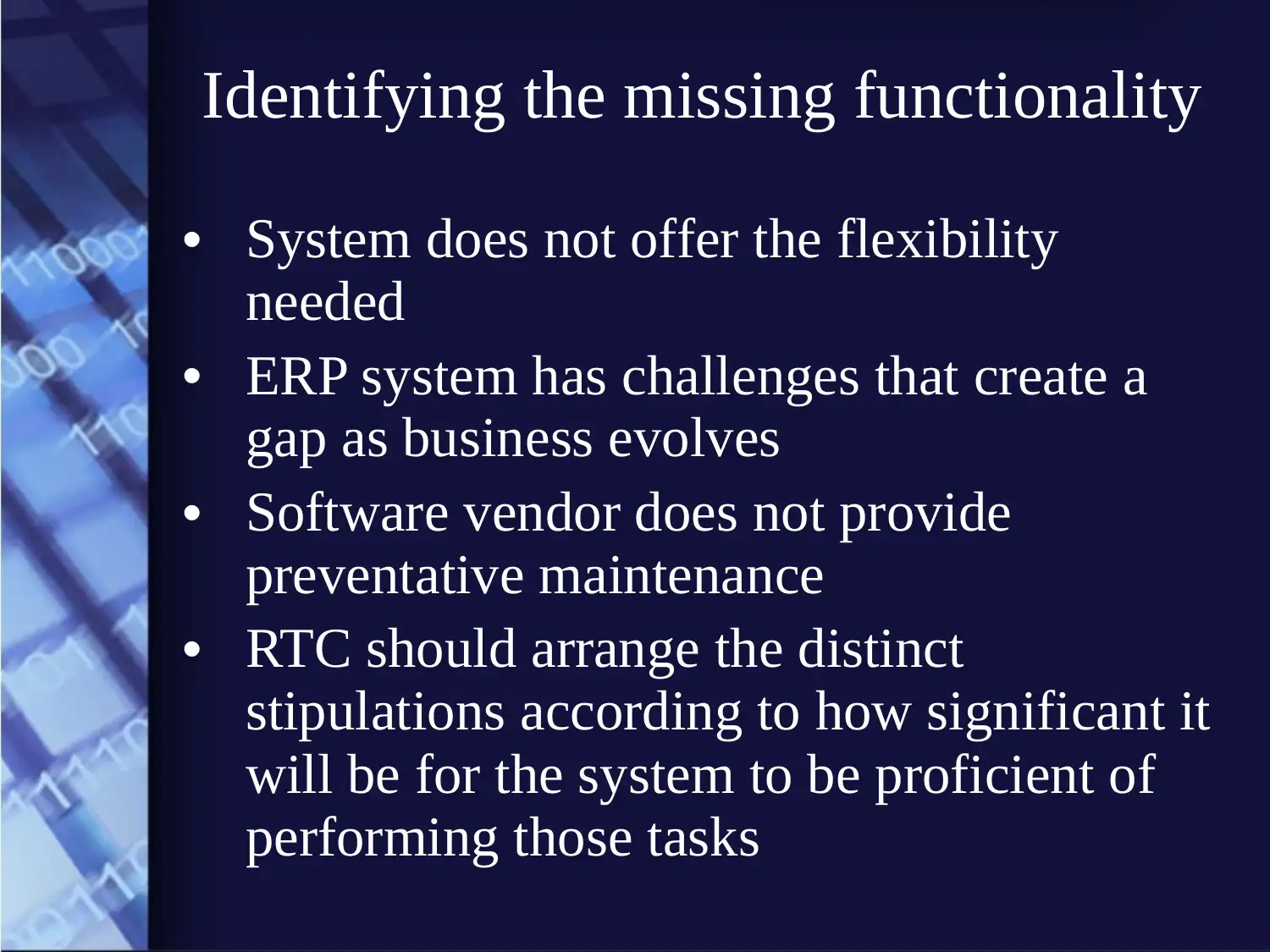
Identifying the missing functionality
• System does not offer the flexibility
needed
• ERP system has challenges that create a
gap as business evolves
• Software vendor does not provide
preventative maintenance
• RTC should arrange the distinct
stipulations according to how significant it
will be for the system to be proficient of
performing those tasks
• System does not offer the flexibility
needed
• ERP system has challenges that create a
gap as business evolves
• Software vendor does not provide
preventative maintenance
• RTC should arrange the distinct
stipulations according to how significant it
will be for the system to be proficient of
performing those tasks

Identifying ERP evaluation criteria
• RTC goals and purposes
• Functional software necessities
• Fundamental technology and future
scalability
• Budget and resources
• BOM (Bill Of Materials)
• Logistics Management
• BI (Business Intelligence)
• B2C Commerce
• RTC goals and purposes
• Functional software necessities
• Fundamental technology and future
scalability
• Budget and resources
• BOM (Bill Of Materials)
• Logistics Management
• BI (Business Intelligence)
• B2C Commerce
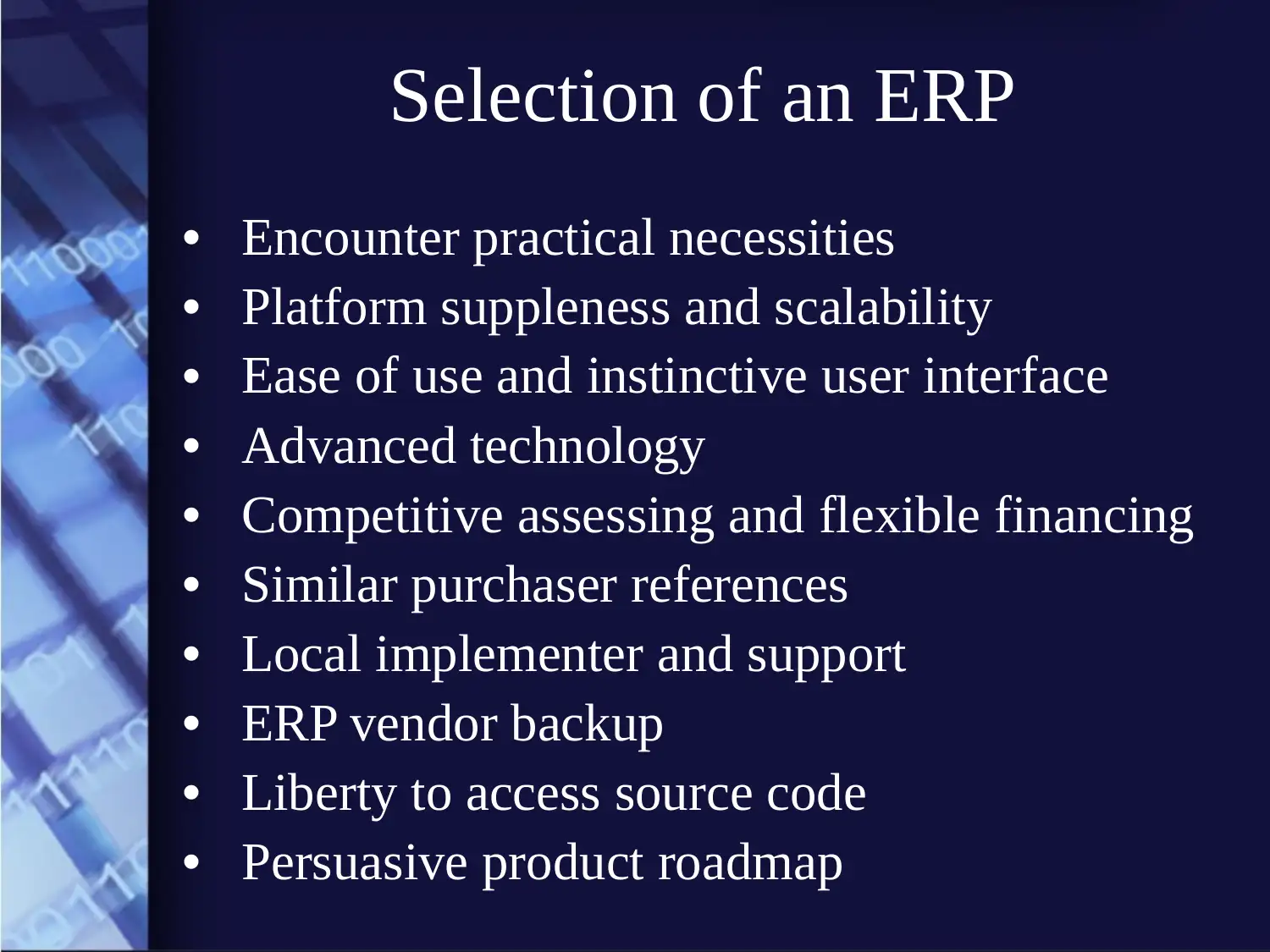
Selection of an ERP
• Encounter practical necessities
• Platform suppleness and scalability
• Ease of use and instinctive user interface
• Advanced technology
• Competitive assessing and flexible financing
• Similar purchaser references
• Local implementer and support
• ERP vendor backup
• Liberty to access source code
• Persuasive product roadmap
• Encounter practical necessities
• Platform suppleness and scalability
• Ease of use and instinctive user interface
• Advanced technology
• Competitive assessing and flexible financing
• Similar purchaser references
• Local implementer and support
• ERP vendor backup
• Liberty to access source code
• Persuasive product roadmap
Secure Best Marks with AI Grader
Need help grading? Try our AI Grader for instant feedback on your assignments.
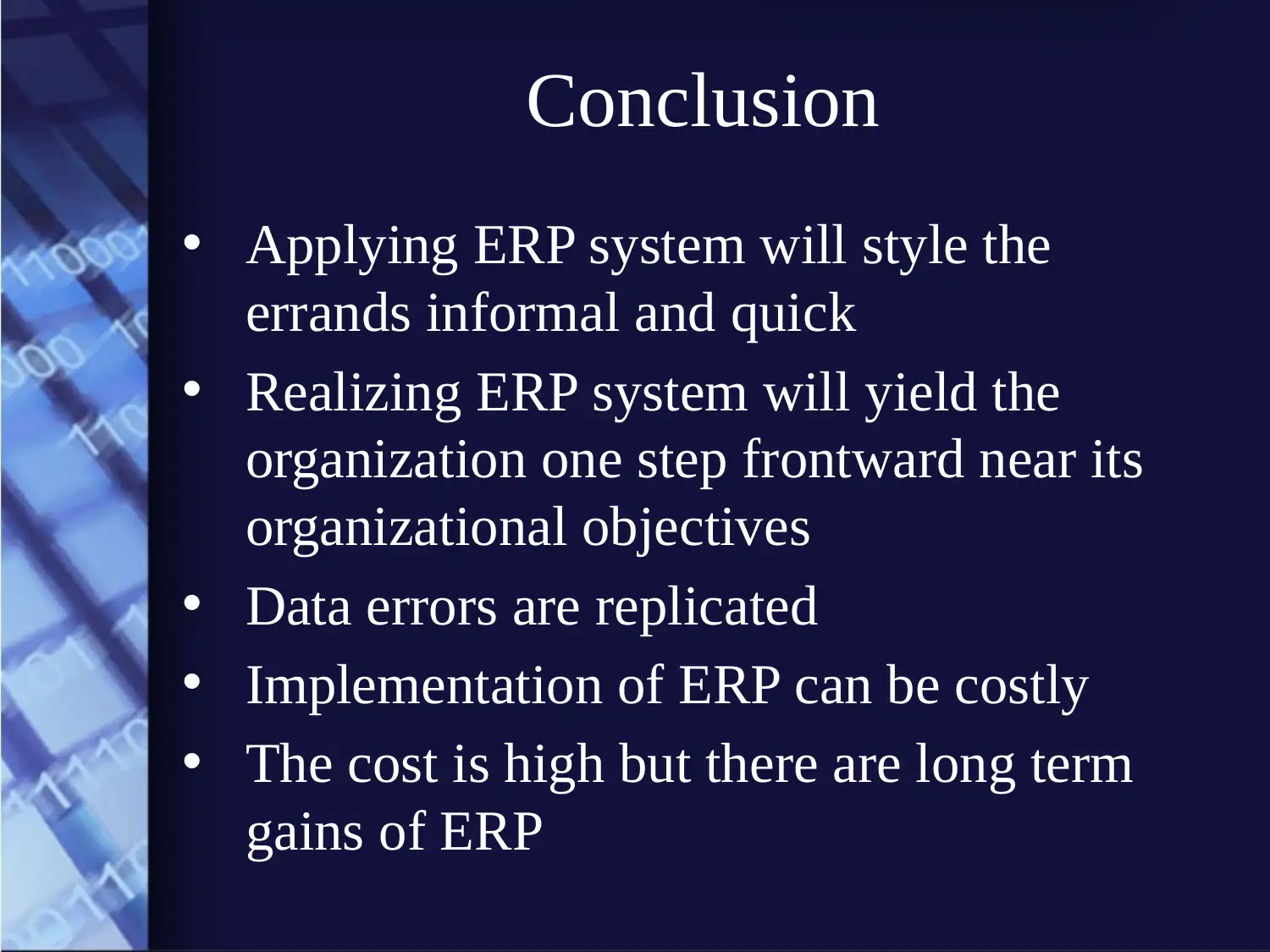
Conclusion
• Applying ERP system will style the
errands informal and quick
• Realizing ERP system will yield the
organization one step frontward near its
organizational objectives
• Data errors are replicated
• Implementation of ERP can be costly
• The cost is high but there are long term
gains of ERP
• Applying ERP system will style the
errands informal and quick
• Realizing ERP system will yield the
organization one step frontward near its
organizational objectives
• Data errors are replicated
• Implementation of ERP can be costly
• The cost is high but there are long term
gains of ERP
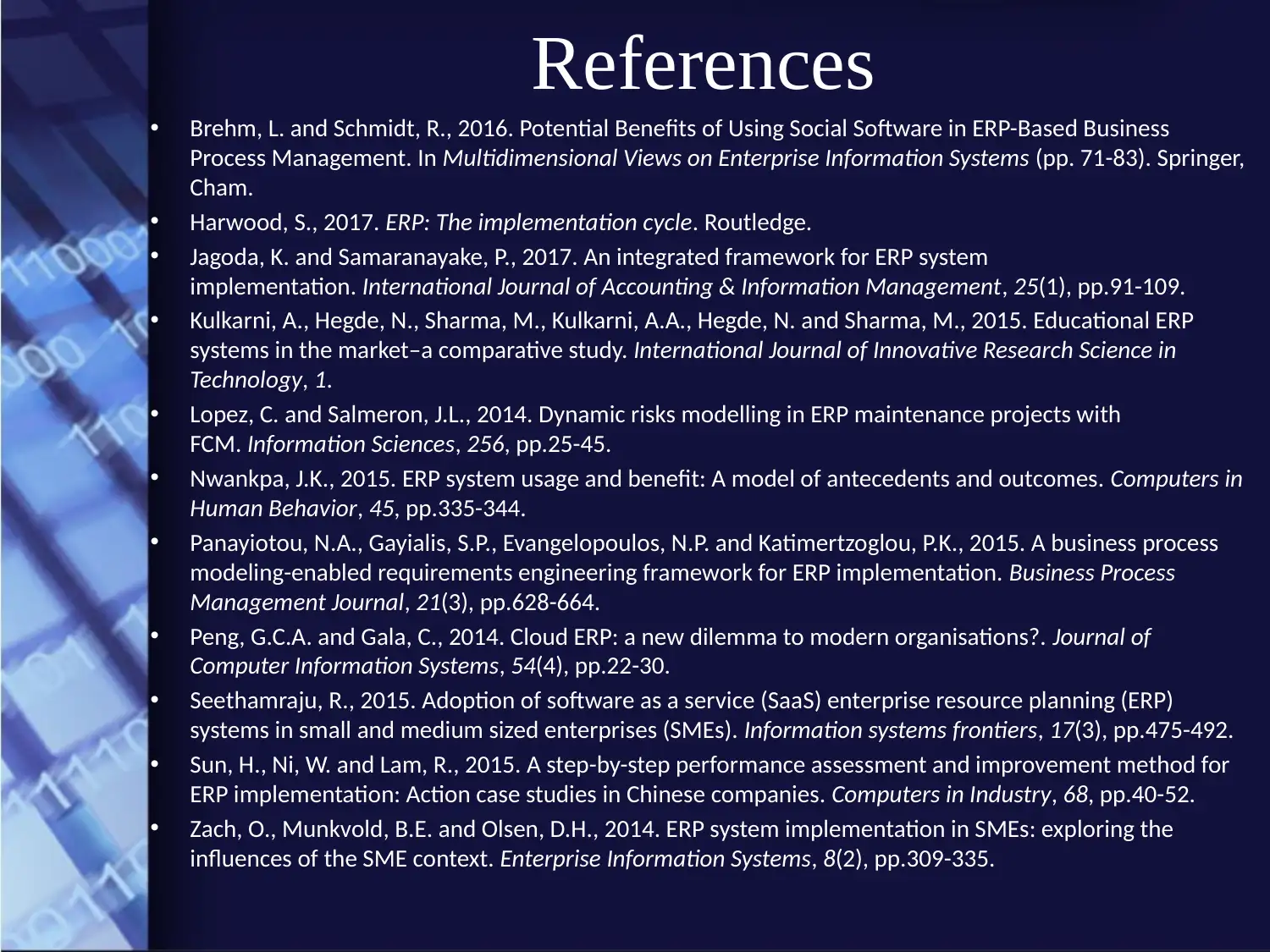
References
• Brehm, L. and Schmidt, R., 2016. Potential Benefits of Using Social Software in ERP-Based Business
Process Management. In Multidimensional Views on Enterprise Information Systems (pp. 71-83). Springer,
Cham.
• Harwood, S., 2017. ERP: The implementation cycle. Routledge.
• Jagoda, K. and Samaranayake, P., 2017. An integrated framework for ERP system
implementation. International Journal of Accounting & Information Management, 25(1), pp.91-109.
• Kulkarni, A., Hegde, N., Sharma, M., Kulkarni, A.A., Hegde, N. and Sharma, M., 2015. Educational ERP
systems in the market–a comparative study. International Journal of Innovative Research Science in
Technology, 1.
• Lopez, C. and Salmeron, J.L., 2014. Dynamic risks modelling in ERP maintenance projects with
FCM. Information Sciences, 256, pp.25-45.
• Nwankpa, J.K., 2015. ERP system usage and benefit: A model of antecedents and outcomes. Computers in
Human Behavior, 45, pp.335-344.
• Panayiotou, N.A., Gayialis, S.P., Evangelopoulos, N.P. and Katimertzoglou, P.K., 2015. A business process
modeling-enabled requirements engineering framework for ERP implementation. Business Process
Management Journal, 21(3), pp.628-664.
• Peng, G.C.A. and Gala, C., 2014. Cloud ERP: a new dilemma to modern organisations?. Journal of
Computer Information Systems, 54(4), pp.22-30.
• Seethamraju, R., 2015. Adoption of software as a service (SaaS) enterprise resource planning (ERP)
systems in small and medium sized enterprises (SMEs). Information systems frontiers, 17(3), pp.475-492.
• Sun, H., Ni, W. and Lam, R., 2015. A step-by-step performance assessment and improvement method for
ERP implementation: Action case studies in Chinese companies. Computers in Industry, 68, pp.40-52.
• Zach, O., Munkvold, B.E. and Olsen, D.H., 2014. ERP system implementation in SMEs: exploring the
influences of the SME context. Enterprise Information Systems, 8(2), pp.309-335.
• Brehm, L. and Schmidt, R., 2016. Potential Benefits of Using Social Software in ERP-Based Business
Process Management. In Multidimensional Views on Enterprise Information Systems (pp. 71-83). Springer,
Cham.
• Harwood, S., 2017. ERP: The implementation cycle. Routledge.
• Jagoda, K. and Samaranayake, P., 2017. An integrated framework for ERP system
implementation. International Journal of Accounting & Information Management, 25(1), pp.91-109.
• Kulkarni, A., Hegde, N., Sharma, M., Kulkarni, A.A., Hegde, N. and Sharma, M., 2015. Educational ERP
systems in the market–a comparative study. International Journal of Innovative Research Science in
Technology, 1.
• Lopez, C. and Salmeron, J.L., 2014. Dynamic risks modelling in ERP maintenance projects with
FCM. Information Sciences, 256, pp.25-45.
• Nwankpa, J.K., 2015. ERP system usage and benefit: A model of antecedents and outcomes. Computers in
Human Behavior, 45, pp.335-344.
• Panayiotou, N.A., Gayialis, S.P., Evangelopoulos, N.P. and Katimertzoglou, P.K., 2015. A business process
modeling-enabled requirements engineering framework for ERP implementation. Business Process
Management Journal, 21(3), pp.628-664.
• Peng, G.C.A. and Gala, C., 2014. Cloud ERP: a new dilemma to modern organisations?. Journal of
Computer Information Systems, 54(4), pp.22-30.
• Seethamraju, R., 2015. Adoption of software as a service (SaaS) enterprise resource planning (ERP)
systems in small and medium sized enterprises (SMEs). Information systems frontiers, 17(3), pp.475-492.
• Sun, H., Ni, W. and Lam, R., 2015. A step-by-step performance assessment and improvement method for
ERP implementation: Action case studies in Chinese companies. Computers in Industry, 68, pp.40-52.
• Zach, O., Munkvold, B.E. and Olsen, D.H., 2014. ERP system implementation in SMEs: exploring the
influences of the SME context. Enterprise Information Systems, 8(2), pp.309-335.
1 out of 18
Related Documents
Your All-in-One AI-Powered Toolkit for Academic Success.
+13062052269
info@desklib.com
Available 24*7 on WhatsApp / Email
![[object Object]](/_next/static/media/star-bottom.7253800d.svg)
Unlock your academic potential
© 2024 | Zucol Services PVT LTD | All rights reserved.




